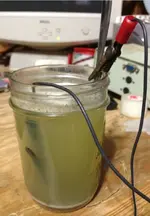chukers
Bronze Member
- Joined
- Feb 1, 2010
- Messages
- 1,819
- Reaction score
- 147
- Golden Thread
- 0
- Location
- Eastland Texas
- Detector(s) used
- Whites V3i - Ace 250 (backup) - Garrett Pro Pointer - Lesche Digger
- Primary Interest:
- All Treasure Hunting
- #41
Thread Owner
Havilah_Springs said:Great Idea!
Questions though:
1. What quantities (ratios) of lemon juice, salt, and water are used?
2. The lemon juice being the acid, will vinegar work instead of lemon juice?
3. I only have a 6 volt power supply, it may take longer, but do you think it will work?
4. Lastly, is the wire with the white markings on the power supply the positive?
Thanks,
Rick (Havilah_Springs)
I use about a cup of water a tablespoon of lemon juice and teaspoon of salt...
I have tried vinegar but I didn't think it worked as well...
yes a 6 volt will work it will just take longer which should also be safer for the object.
yes the white line wire is positive
Chukers




 You are separating the Hydrogen from the Oxygen, and the Hydrogen gas is extremely flamable, so best to do this in a well ventelated area to avoid the Big Bang Theory.
You are separating the Hydrogen from the Oxygen, and the Hydrogen gas is extremely flamable, so best to do this in a well ventelated area to avoid the Big Bang Theory. 






